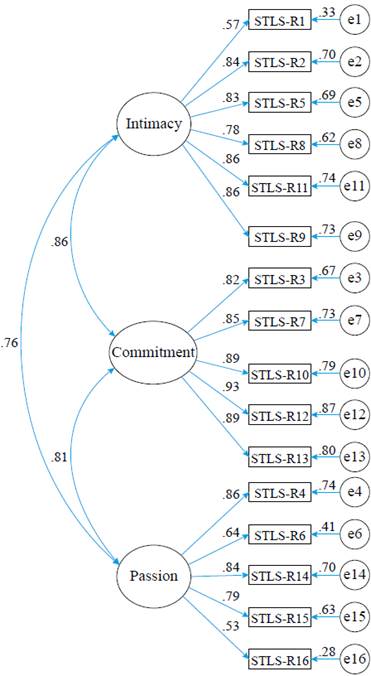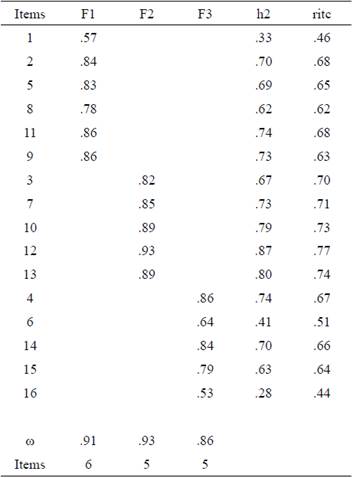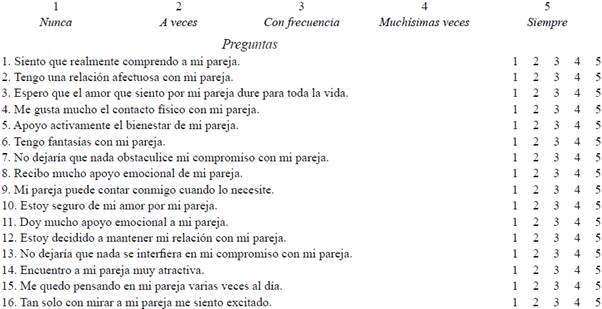Introduction
Love is a universal phenomenon (Al-Krenawi & Jackson, 2014), very important in the context of close relationships (Graham, 2011), which has been subject of considerable attention and discussion over the past years (Wan Shahrazad, Hoesni & Chong, 2012). Despite this fact, to date, there still is a lack of a unified scientific approach that enables exhaustive studies concerning this intriguing phenomenon (Pilishvili & Koyanongo, 2016).
From the psychological perspective, love was initially conceived as an effort to achieve the ego-ideal (Freud, 1922) as well as a need that causes adversity in relationships that if not satisfied, might hamper the self-realization of individuals (Fromm, 2004; Maslow, 1991). On the other hand, some authors refer to love as a deep sense of affection towards someone else (Vera, 2017). Nevertheless, in some cases, this definition might disregard important cognitive, affective and behavioral processes involved (Hatfield, Rapson, & Martel, 2007). There are other definitions of love that are subject to one's interpretation and to the social circumstances of individuals (Le Breton, 1999), as can be observed within the context of the concept Amae practiced in Japanese descendants in Bolivia (Sakuray & Akemi, 2014). In addition, expressions of love can vary from one society to another. For instance, companionate love, which stressed commitment, is typical in collectivist societies while passionate love is highly regarded in individualistic societies (Kim & Hatfield, 2004). On the other hand, some authors argue that there is a transcultural impact in the conceptualization of love due to the influence of cultural globalization and international media such as television, films, and Internet (Vera, 2017).
In fact, since the early 1970s, on the basis of the seminal works of Rubin (1970), several theoretical models have been developed to understand love from a psychological perspective (Sternberg & Barnes, 1988). In such a sense, depending on the theoretical perspective, love can be considered a feeling (Precht, 2012), an act of will (Fromm, 2004; Scott, 1997), a choice (Singer, 2006) or an event that goes beyond the partnership framework (Ortega & Gasset, 1939/2005).
Naturally, the variety of definitions (Hatfield, Bensman, & Rapson, 2012), creates different ways of classifying love (Neto & Conceição Pinto, 2015) which develop in the biocultural, sociocultural, individual, evaluative and behavioral fields (Díaz-Loving & Sánchez, 2002). In this sense, Lee (1977) has differentiated between six types of love: Eros (passionate love), Ludus (ludic love), Storge (friendship love), wherein combinations of these three can result into the so-called Mania (possessive love), Pragma (pragmatic love), and Agape (selfless love). Likewise, the existence of passionate and companionate love (Hatfield & Rapson, 1996), corporal, sentimental and existential love (Frankl, 1997), affective, cognitive and interpersonal love (De Zubiría, 2002), as well as passion, intimacy and commitment (Sternberg 1986) have also been mentioned. This shows that the different perspectives concerning love have varied considerably with diversity of orientations and psychological schools (psychoanalytic, cognitivism, behaviorism, humanistic, among others). As a consequence, to date, there is no universally agreed upon general definition of love (Levin & Kaplan, 2010).
For some authors (Mazadiego & Norberto, 2011), the widely theoretical model currently used is the Sternberg's triangular love theory (Sternberg, 1986). This is because of its fairly general capability to comprehend the love experiences between individuals of different societies (Gao, 2001). Nonetheless, this model has not been studied thoroughly in the Peruvian context, due to the fact that there is only one validation of the long version of the scale of love in Peruvian youth and adults.
Sternberg's model proposes that love can be inferred as a combination of three components: intimacy, passion, and commitment (Sternberg, 1986). Intimacy is defined as a degree of trust, nearness and connection in a relationship. This component relies upon emotions that comprise a warm experience in a relationship (Diessner, Frost & Smith, 2004). Passion is the force that leads to romance i.e., physical or sexual attraction. Lastly, commitment implies a decision to love and being loved as well as the willingness to maintain love over time (Sternberg, 1986).
The interaction of the mentioned components give rise to seven other forms of love which are: liking (only intimacy is experienced), infatuated love (only the passion component is present), empty love (the commitment component dominates), romantic love (combination of intimacy and passion), companionate love (blend between intimacy and commitment), fatuous love (interrelation between passion and commitment), consummate love (a combination of the three components). Accordingly, the lack of love is understood as a state where the three components are absent (Heinrich, Albrecht & Bauer, 2012).
Based on this theoretical model, the Sternberg's triangular love scale (STLS; Sternberg, 1997), that measures the components of intimacy, passion and commitment, was constructed. Originally, the 36-item STLS was validated in a sample of 84 American adults. There, the participants responded six times each scale, describing the love they felt toward their mothers, fathers, sisters, friends of the same sex, persons whom they loved and finally, an ideal lover. The psychometric analysis of the first STLS version indicated the presence of alpha coefficients greater than 0.80, with the commitment component slightly lower (α = 0.79). Also, high correlations among the three components were observed, while not all items presented high saturations in the initially expected components, which caused problems in the factorial analysis of the STLS. In a second study, Sternberg (1997) replaced the problematic items and included three items in each component, giving rise to a second 45-item STLS version. This version showed alpha coefficients greater than 0.90 and correlations between the components of 0.71 and 0.73.
In fact, several psychometric studies around the world have reported evidence of validity and reliability similar to the one originally reported by Sternberg (1997). For instance, in Latin America, STLS has been validated in some countries including, Mexico (Mazadiego & Norberto, 2011), Brazil (Cassepp-Borges & Pasquali, 2012; Cassepp-Borges & Teodoro, 2007; Hernández, 1999) and Peru (Ventura-León & Caycho-Rodríguez, 2016) although recently it has been suggested that the structure of the 45-item STLS is very complex when compared with other reduced versions STLS-R (Evangelho, 2016). In fact, many items of the original version load in more than one factor, so when they are removed it is possible to keep a fair level of precision in STLS-R with Cronbach's alpha index above .85 (Cassepp-Borges & Pasquali, 2014). Consequently, reduced versions of STLS-R have been developed in the Netherlands- where a 19-item version has been validated (Overbeek, Ha, Scholte, de Kemp, & Engels, 2007) -and Brazil where 15-item (Gouveia, Fonseca, Cavalcanti, Diniz, & Dória, 2009); 16-item (Cassepp-Borges & Martins, 2009; Andrade, García, & Cassepp-Borges, 2013) and 20-item (Cassepp-Borges & Pasquali, 2014) versions have been developed.
In this context, and considering the current success of reduced STLS-R versions, the present study aims: (a) to translate a reduced Sternberg's Triangular Love Scale (STLS) from its original language (Portuguese) into Spanish; (b) to determine the factorial structure of STLS-R by using confirmatory factor analysis: (c) to estimate the reliability, using the internal consistency method, by means of the Omega coefficient: (d) to evaluate the factorial invariance (FI) across gender. In this regard, it is worth noting that, as far as we know, the FI of STLS-R as a function of gender has not been previously addressed. This fact naturally opens the question on whether or not the STLS-R items have the same meaning for men and women.
The relevance of this study relies on the fact that within the Peruvian framework, only a 45-item STLS (Ventura-León & Caycho-Rodríguez, 2016) has been validated and it did not consider the structural equation approach. In addition, the validation of a reduced love scale in young and adult Peruvian couples certainly shed some light on the love phenomenon and its interrelation with other variables such as satisfaction (Lemieux & Hale, 2000), sexual conduct (Martínez & Rodas, 2008) or positive and negative emotions (Kim & Hatfield, 2004). Furthermore, evaluating the FI of STLS-R has important implications for understanding love differences between men and women. Despite this fact, only few studies have addressed these differences between men and women, separately, using the STLS (Collins, Welsh, & Furman, 1999; Ha, Overbeek, de Greef, Scholte, & Engels, 2010; Seiffge-Krenke, 2003; Lemieux & Hale, 2000), reporting that men demonstrate higher levels of passion, lower intimacy levels and similar levels of commitment with respect to women. However, such differences might not be significant (Gao, 2001; Ha et al., 2010) as the absence of FI evidence could lead to a misinterpretation of the findings associated with subgroup differences (Cheung & Rensvold, 2002).
Method
Participants
The study was comprised of 988 Peruvian youth and adults, being 748 women and 240 men, whose ages ranged from 16 to 54 years (Mean = 21.26; SD = 3.83), and who had been in a relationship for at least one month. The participants were either married, living with their partners, engaged, or dating. All the participants belonged to a middle social class in regard to socioeconomic status. In order to better control age variability, the participants were divided into three groups: From 16 to 19; from 20 to 21; and from 22 to 54 years. For further details, see table 1. For the factorial invariance analysis, 240 women were selected randomly from the total (n=988). This was done to equate the subgroups according to gender (Van de Schoot, Lugtig, & Hox, 2012).
Instrument
A Portuguese version of the reduced Sternberg's love scale (STLS-R; Andrade, et al., 2013) was used. The scale was composed of 16 items with Likert-like alternatives going from 1=Never to 5=Always (see appendix A). The validity of the STLS-R was confirmed by exploratory and confirmatory factorial analysis indicating the presence of three factors that underlay the items, consistent with Sternberg's theory. The internal consistency reliability was estimated by using Cronbach's alpha coefficient which oscillates between .81 to .87.
Procedure
For carrying out this work the ITC guidelines were followed ([International Test Commission, ITC], 2017). Initially, ethics approval for the current study was granted by the Board of Ethics of the Northern Private University. The translation-back translation approach was used to translate the STLS-R. That is to say, a non-affiliated bilingual person translated the scale from Portuguese to Spanish, while a second person translated the Spanish version back to Portuguese. Then the items were evaluated by the people who participated in the translation and the authors with the objective of resolving minor discrepancies and coming to a consensus on the translation. Next, the translated version was submitted to a pilot group with similar features to the final sample to ensure the comprehension of the items and prevent any kind of bias from arising due to linguistic issues, while at the same time being careful to maintain the semantic equivalence. For the sake of completeness, the original version and the Peruvian version of STLS-R is shown in Table 2.
Table 2 Original version in Portuguese and translation of the Peruvian version STLS-R
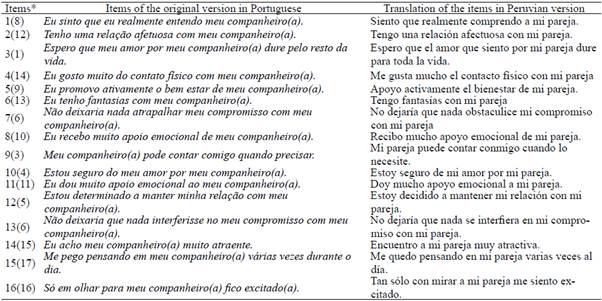
* The numbers in parentheses correspond to the original enumeration in Portuguese.
The application of STLS-R was performed in two ways: (a) In person (60%), where young and adult college students were surveyed near the college facilities such as: rest areas, cafeterias, and gardens; (b) On-line (40%), through on-line forms shared in social networks. These two forms of evaluation were established as a way to access a larger number of participants. For each one of the applications an informed consent was established by explaining conditions of anonymity, voluntary participation, confidentiality and veracity of information provided to the researcher.
Data analysis
The statistical analysis was carried out with the software "R" version 3.6.0 (R Development Core Team, 2019). Thus, the analysis was conducted in three steps: In the first stage, a descriptive statistical analysis including the mean, standard deviation, asymmetry and kurtosis was performed. In the second stage, the confirmatory factorial analysis (CFA) was chosen, instead of the exploratory factorial analysis (EFA), since the scale seeks to capture the Sternberg's theory features that are three-dimensionally defined. So, the technique should confirm the previous theoretical assumption (Arias, 2008). Thus, the CFA intended to provide evidence that only three factors best explain the subjects' responses, how the factors relate among them and how much the items loaded each factor (Lloret-Segura, Ferreres-Traver, Hernández-Baeza, & Tomás-Marco, 2014).
The CFA that was calculated through the library "la-vaan" (Rosseelet al., 2018) was also carried out by using a polychoric correlation matrix as we are dealing with ordinal variables (Sanduvete-Chaves, Lozano-Lozano, Chacón-Moscoso, & Holgado-Tello, 2018). In order to test the multivariate normality, the Mardia coefficient was calculated with a value < 70 (Rodríguez & Ruiz, 2008), which would indicate that it is necessary to test a robust estimator. Otherwise, an Unweighted Least Squares (ULS) estimator is preferred over the Weighted Least Square Mean and Variance Adjusted (WLSMV), as it is a valid option before ordinal variables (Jöreskog, 2003; DiStefano & Morgan, 2014). The goodness-of-fit indices suggested by Mueller & Hancock (2008) were reported: Rate between Chi-square and degree of freedom [χ2/df] whose recommended values must be below 2 (Tabachnick & Fidell, 2007), although higher values can be admitted (Wheaton, Muthen, Alwin, & Summers, 1977); the root-mean-square error of approximation, RMSEA <.06 indicates the quality of adjustment; the standardized root mean residual, SRMR <.08 is optimal and finally, the comparative fit index CFI ≥.95 indicates a fair fit of the data (Browne & Cudeck, 1993; Hu & Bentler, 1999).
In light of the evidence provided about the internal structure of the study at first, it was proceeded to evaluate the FI of STLS-R on three levels (Byrne, 2008). Evaluating the configurational invariance this way implies checking whether the STLS-R scores are represented by the same amount of latent factors and free and fixed loading factors in both (Yap, et al, 2014); metric invariance, which suggests verifying if the factor loading is equal between groups (Hirschfeld, & Von Brachel, 2014); strong invariance, which implies that the threshold is equivalent for both men and women (Schmitt & Kuljanin, 2008). Additionally, the latent mean measurements were compared (Dimitrov, 2010).
The configurational invariance was checked with the Hu and Bentler (1999) criteria: CFI >.95; RMSEA ≤.06. For the comparison of the strong and metric invariance, it was taken as a reference that the differences between the CFI were below .010 in CFI; 0.15 in RMSEA; SRMR in .030 (Chen, 2007).
Finally, since the tau-equivalence was not satisfactory (Zinbarg, Revelle, Yovel, & 2005) the reliability was estimated by means of the Omega coefficient (ra), which is recommended for factor models (McDonald, 1999).
Results
Preliminary analysis of items
In table 3, the central tendency and variability measures are presented. The mean reveals that item 9 ("My partner can count on me when he/she needs") presents the highest value while item 16 ("Just by looking at my partner I feel excited") presents lowest value. The standard deviation of items 3, 6, 15, 16 was the highest with values greater than one. On the other hand, all items have negative asymmetry that reveals a tendency towards higher scores. Accordingly, kurtosis of items 4, 5, 9, 10, 11, 12 present a higher concentration of data around the center of its distribution.
Additionally, the Mardia coefficient whose value is equal to 41.13 is calculated; the same one that is lower than 70, being unnecessary to attenuate the data, thus choosing an estimator like ULS instead of WLSMV.
Confirmatory factor analysis (CFA)
In order to verify the factor structure of the theoretical proposal, CFA is used. Therefore, a three-dimensional factor structure composed by 16 items was modeled. This model presents the following satisfactory goodness-of-fit parameters: (χ2 (101) = 349.85; χ2/df =3.46; CFI =.99; RMSEA=.05 [.04, .06]; SRMR = .05). The factor loading, and the inter-factor correlation are shown in Figure 1.
Table 3 Preliminary item analysis (N = 988)
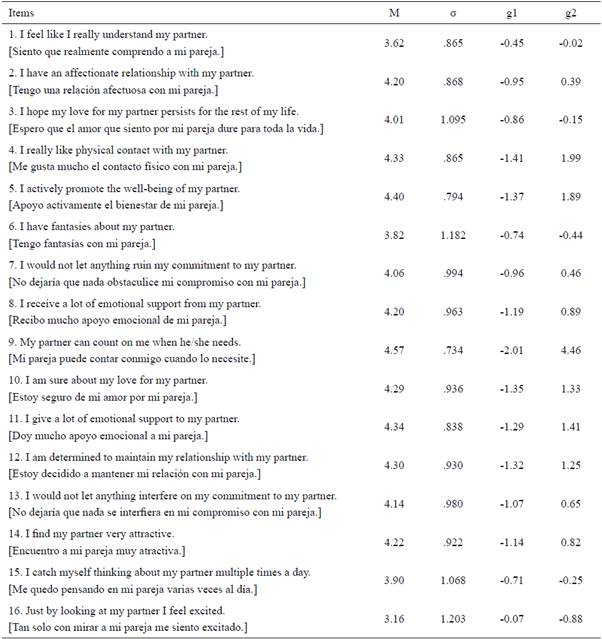
Note. M = Mean; σ = Standard Deviation; g1 = Asymmetry; g2 = Kurtosis
Invariance across gender
Once the STLS-R factor structure was identified, the invariance across gender was progressively explored: configurational invariance (M1), metric invariance (M2), strong invariance (M3, Byrne, 2008). First, the model adjustment was examined without constraints in both subgroups (men and women) obtaining similar values. Subsequently, the STLS-R structure between subgroups (configurational invariance, M1) was analyzed, presenting optimal values, with χ2 (202) = 203.20; CFI =.1; SRMR =.050 y RMSEA = .004 (.000, .025). These results indicate that M1 can be a referential model upon which one can set up constraints in models M2, M3, M4.
Moreover, the metric invariance (M2), defined as M1 with restrictions on the factor loading, was carried out, finding the following appropriate indices: CFI = .999 and RMSEA = .020 (.000, .032). It should be noted that the values between ΔCFI are lower than the required cut-off point (ΔCFI = .010 y ΔRMSEA = .015; SRMR = .030; Chen, 2007), which indicates the equivalence between the factor loading. Based on that, it is possible to compare the invariance of the covariances. Then, the equivalence between thresholds was verified (strong invariance, M3) where the difference between the CFI was below 0.010 (Chen, 2007). The above indicates that the thresholds are invariant, so it is possible to compare latent means between the subgroups (Dimitrov, 2010).
The latent factor means for each factor were estimated. With respect to intimacy, it is observed that women (M=5.89) present a slightly higher value than men (M=5.75); although the sample effect is negligible (d=.15). Similarly, for the commitment factor, the means are almost the same for both groups (M=5.15) and the sample effect can be neglected (d=.10). Finally, the mean for the passion factor of men (M=4.37) was slightly higher than for women (M=4.17) with a small sample effect (d=.23).
Discussion
This study aimed to explore the internal structure, reliability and factor invariance according to sex of the STLS-R for Peruvian youth and adults. The results of CFA confirmed that the three-dimensional model shows satisfactory goodness-of-fit indices. This result is in line with previous reports in Latin America (i.e., Andrade, et al., 2013; Cassepp-Borges & Martins, 2009; Cassepp-Borges & Pasquali, 2014; Gouveia, et al., 2009), even though different versions of STLS-R had been used. A deeper discussion of main findings will be presented in detail as follows:
Regarding the reliability of the ω coefficient, it was above .85 for all dimensions, where the passion factor presented the lowest value (ω = .86). This is consistent with previous studies (Cassepp-Borges & Pasquali, 2014; Cassepp-Borges & Teodoro, 2007; Cassepp-Borges y Pasquali, 2012; Hernández, 1999; Andrade, et al., 2013). The coefficient ω was chosen since it is considered adequate when factor analysis is used (Mcdonald, 1999).
On the other hand, the results show the presence of factor invariance with respect to gender. The presence of configurational invariance implies that the three-factor model is valid for men and women. In this regard, from a psychological perspective, both genders present the same components of love when answering the STLS-R. With respect to the metric invariance, these results indicate that the factor loading is equal between the groups (Lievens, Anseel, Harris, & Eisenberg, 2007). From this, it can be inferred that both men and women give the same relative importance to all the items. The presence of strong invariance indicates that people might obtain similar love scores regardless their gender. Finally, the achievement of strict invariance proves the equivalence in the items' error variation for both groups (Millsap & Kwok, 2004).
Since it was possible to demonstrate the strong invariance, it was proceeded to estimate the latent means (Dimitrov, 2010) which reveals that women are more intimate while men are more passionate; but its size of effect is considered negligible. This aligns with previous studies (Ahmetoglu, Swami, & Chamorro-Premuzic, 2009; Sumter, Valkenburg, & Peter, 2013) and highlights that the observed differences in love, between men and women, can be attributed to differences between groups (Schmitt & Kuljanin, 2008).
It should be noted that besides the solid methodology and theoretical basis, the present study has some limitations. First, by including only youth or adults in the sample, the possible generational differences could be suppressed which may have somehow biased the overall results and limited the ecological validity, a situation that must be addressed in further studies.
In this sense, the FI of STLS-R can be investigated in different age groups to ensure whether the items of STLS-R have different meaning for men and women of different age ranges. In the sample studied, there is a substantial difference between the group of men and women. Indeed, such explored differences according to sex, must be considered with caution. Furthermore, it is advisable that future research guarantee the equivalence across groups. Secondly, the participants are from Lima, Peru, so one should expect that the findings might not be representative of the general Peruvian population of youth and adults. Additionally, there is a considerable difference in the numbers of men and women that can be monitored in future studies. Third, the present study does not provide information on the evidence of convergent and discriminant validity of STLS-R. This suggests that further studies are necessary in order to determine how different STLS-R is from other love measurements. Finally, test-retest and longitudinal FI reliability was not tested.
In summary, it was confirmed that the three-dimensional structure of STLS-R offers satisfactory goodness-of-fit indices to compare men and women. Therefore, STLS-R appears to be a valid and precise instrument to measure love in youth and adults from Lima, Peru. Based on these results, it is important to continue evaluating other sources of variation (for example, culture or age) that are important to achieve a deep understanding of love in Peruvian youth and adults of both genders. To this aim, the limitations described in this study must be taken into account. Therefore, the STLS-R has a clear advantage over other versions of the STLS due to its smaller number of items, which can be valuable for future investigations on romantic relationships.











 text in
text in 


